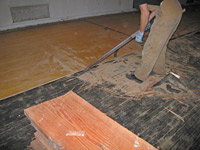Cost–effectiveness of jobsite diversion/recycling
Are there dollars in your dumpster?
It may be easier and less expensive to divert your jobsite waste from the landfill than to dispose of it. Sending materials for reuse often doesn't cost a contractor anything and recycling fees are generally lower than disposal fees. There are many reuse and recycling options available in King County.
Determine project waste
Determine the types of materials you will divert for reuse and recycling at the jobsite.
- Use engineering estimates, previous material purchasing records or previous waste disposal records, including wastes from demolition, as a guide to estimate the types of construction materials that the project will generate.
- Estimate the quantity of each material the project will generate in cubic yards or tons.
- Keep recycling and garbage disposal receipts for reporting purposes and to accurately estimate the quantities generated on future projects.
- Identify the types of materials that can be reused or recycled during the project. The Construction Recycling DirectoryDownload PDF 1 MB can be a good resource for identifying these materials.
- Include the more unusual materials such as plastic, ceiling tiles, paint, asphalt roofing and carpet in your plan.

Choose a diversion method
There are several options for collecting and delivering materials to reuse or recycling facilities.
- Contract with a salvage company to recover jobsite materials that are reusable
- Separate recyclables at the source for recycling. This method involves collecting recyclables in separate containers as they are generated. The hauler takes the sorted materials to a recycling facility. Materials not accepted in commingled recycling loads, such as carpet or ceiling tile, must be source-separated for recycling.
- Contract with a recycling hauler that accepts commingled construction and demolition materials. This method allows you to put multiple recyclables such as wood, cardboard and metals in one container. The hauler takes the materials to a sorting facility where the materials are then separated for recycling.
- Combine the two methods above for a 3-bin system. One for commingled recyclables, one for garbage, and one for phase appropriate source separated materials (clean wood bin during framing, drywall bin during drywalling, etc.)
- Self-haul your materials. Source-separate materials in piles or containers on site and haul them to a local salvage company, recycling facility or C&D transfer site yourself. You also may be able to drop off commingled loads at certain C&D processing facilities.
For additional information on choosing a recycling plan, refer to the pros and cons of separating C&D.
Calculate costs and savings
Once you have established a plan for recycling and reusing materials, you can determine the cost-effectiveness of your efforts by using the Recycling Economics Worksheet (Microsoft Excel® Document) to calculate your disposal and recycling costs. The worksheet contains separate calculation sheets for commercial-hauling and self-hauling options, as well as samples of completed worksheets.


 Translate
Translate
